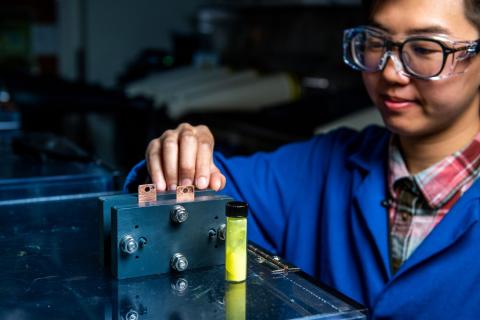
Electrochemical
Energy Storage
Electrochemical
Energy Storage
Higher-performance batteries
for the grid, vehicles, and sensors
Higher-performance batteries
for the grid, vehicles, and sensors
Shannon Colson | Pacific Northwest National Laboratory
For transportation, the grid, and applications such as sensors, industry seeks lower-cost, higher-performance batteries with greater reliability and safety than those available in today’s market. To address this need, PNNL plays a key role in developing new materials and processes that are resulting in improvements to lithium-ion and lithium-metal batteries, redox flow batteries, and other battery chemistries.
PNNL’s extensive energy storage research and development supports the U.S. Department of Energy’s Office of Electricity (OE), Energy Efficiency and Renewable Energy Office, and Office of Science. Our researchers apply expertise to optimize performance of new materials, scale-up new materials and processes, validate performance by building prototypes at industry-relevant scales and then test them under realistic operating conditions.
Energy storage for the grid
Stationary energy storage systems help harden the power grid and make it more resilient. Technologies that can store energy as it’s produced and release it when it’s needed, support the delicate balance of the power grid. To address manufacturing challenges for advanced battery materials and devices, our PNNL energy storage experts are engaging in public-private partnerships with entities ranging from major corporations to prestigious universities, with a focus on de-risking, scaling, and accelerating adoption of new technologies. The Grid Storage Launchpad accelerates development of next-generation grid and transportation energy storage technologies that are critical to supporting a reliable, affordable, secure, and resilient electrical grid.
PNNL researchers are making grid-scale storage advancements on several fronts. Yes, our experts are working at the fundamental science level to find better, less expensive materials—for electrolytes, anodes, and electrodes. Then we test and optimize them in energy storage device prototypes.

PNNL energy storage scientists engage regularly with our power grid researchers. They publish frequently in peer-reviewed journals to push the state-of-the-art in energy storage, with over 150 publications in 2025 alone.
Supported largely by DOE’s OE Energy Storage Program, PNNL researchers are developing novel materials in not only flow batteries, but sodium, zinc, lead-acid, and flywheel storage systems that are boosting performance, safety, and reliability of grid scale storage.
With PNNL’s research and development facilities, researchers are able to scale-up promising electrode and electrolyte materials and help tackle the challenges in manufacturing these next-generation grid-scale batteries to support DOE’s mission.
Batteries for transportation
PNNL energy storage experts are leading the charge in batteries for transportation applications on behalf of DOE’s Battery500 Consortium. PNNL is leading the Battery500 Consortium, which consists of four national labs and five universities. In addition, there are projects across the country to support the consortium.
By implementing the innovations developed under the Battery500 Consortium, a record of 600 stable cycles has been demonstrated in a prototype 350-Wh/kg lithium-metal pouch cell. The consortium has also developed a 400-Wh/kg lithium-metal pouch cell and now is pushing toward 500Wh/kg.

Patents derived from the consortium have already been licensed to large domestic companies. Researchers in the consortium also developed Li-Batt Design App to help battery developers and researchers easily and rapidly design lithium-metal-based pouch cells. In its first year, the software generated four revenue-bearing licenses and one government-use agreement, with many more entities evaluating the software and considering a site license.
As part of another DOE collaboration, the Silicon Consortium Project, our teams are using specialized PNNL characterization capabilities to examine the interfacial reactions on anodes made from silicon. The research is helping to understand why silicon-based lithium-ion batteries have short life spans. PNNL is supporting other organizations to enhance the calendar life of silicon-based lithium-ion batteries.
For vehicles propelled by hydrogen fuel cells, the PNNL energy storage team is developing new catalysts not made from more costly platinum group metals—which can account for half the cost of the fuel cell.
Sensor applications
PNNL is using new materials and cell designs to develop improved batteries that meet targeted performance metrics for sensor applications. Our teams are developing and deploying state-of-the-art micro-batteries for miniaturized sensors, producing up to 1,000 units every year.

